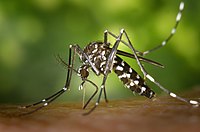
Photo from wikipedia
Aedes (Stegomyia) albopictus is a mosquito originating from the Asian continent, which was detected in the Americas in 1985 and Brazil in 1986. Due to its rapid expansion throughout Brazil,… Click to show full abstract
Aedes (Stegomyia) albopictus is a mosquito originating from the Asian continent, which was detected in the Americas in 1985 and Brazil in 1986. Due to its rapid expansion throughout Brazil, this species has already been reported in 26 of the 27 federative units of Brazil. In this review, we evaluate some of the biological, epidemiological and ecological characteristics of Ae. albopictus through critical analysis of their importance in the pathogen transmission dynamics, since its first record in the country. We show that immature forms of this species are frequently found in artificial breeding sites whereas females exhibit anthropophilic behavior despite its eclecticism on blood feeding. In addition, Ae. albopictus shows advantages in interspecific competition with Ae. aegypti for both immature and adult stages. Taking together, these aspects as well as its vector competence indicate that Ae. albopictus could act as a bridge vector between sylvatic and urban pathogen transmission cycles. We conclude by pointing to the need of continuous surveillance of Ae. albopictus in Brazil and raise several questions that still need to be answered.
Journal Title: Acta tropica
Year Published: 2020
Link to full text (if available)
Share on Social Media: Sign Up to like & get
recommendations!